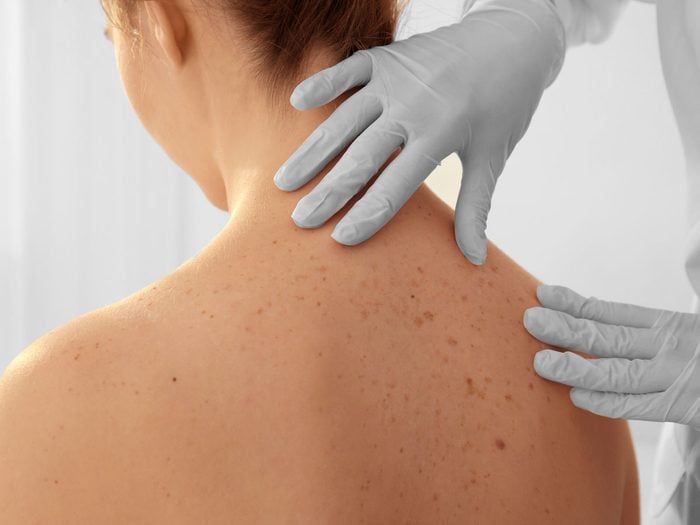
The signs of skin cancer
You’ve likely been told to look out for moles that change colour or size, but many more common types of skin cancer don’t look like moles at all.
Skin cancer can come in the form of red sores, wart-like bumps, or even scaly patches. “We tell people to look for anything new, or anything that doesn’t heal after a while,” explains Cheryl Rosen, a dermatologist at Toronto Western Hospital.
Read on to learn about the various types of skin cancers, what they look like, and how they’re treated.

Pre-cancerous: Actinic keratosis
What it is: Actinic keratosis is the most common pre-cancerous for of skin cancer. It usually develops in older adults in areas where the skin has accumulated decades of UV exposure. (Plus, these are the best mineral sunscreens to reflect the sun’s harsh rays.)
What it looks like: An actinic keratosis looks much like a scaly spot or a rough patch on the top layer of the skin. In many cases, patients will develop more than one actinic keratosis.
How it’s treated: Actinic keratosis is most often treated by freezing, burning, cutting out or scraping away the lesion.
Cancerous: Melanoma
What it is: Melanoma is the least common form of skin cancer, and if caught early have a high treatment success rate. So those with fair skin, a family history of melanoma, or have a history of high sun exposure should be on the look out for signs to catch it in its earliest stage.
What it looks like: The popular conception is that melanoma occurs on an already existing mole, and while that does happen, most melanomas occur as a completely new mole. Melanoma moles are often asymmetrical and may be somewhat colourful. In addition to brown, one may see black, red, pink, gray, or blue. A giveaway is that the mole will change in shape and are usually larger than the size of a pea.
How it’s treated: Early stage melanomas need to be surgically removed, while more advanced melanomas may require chemotherapy or radiation therapy.
(Check out these new skin cancer treatments that are prolonging the lives of patients with advanced melanoma.)

Cancerous: Basal cell carcinoma
What it is: Basal cell carcinomas are usually found on sun-exposed areas, such as the face and neck. They also tend to grow so slowly that they rarely cause any harm.
What it looks like: According to Dr. Rosen, basal cells look like a raised bump on the skin or a red scaly patch that doesn’t go away.
How it’s treated: Some basal cell carcinomas can be treated with a cream that’s applied daily for several weeks, while others are below the surface and need to be surgically removed. “Basal cell carcinoma is really curable,” says Dr. Rosen, “but it can leave you with a scar that can be quite noticeable.”
Cancerous: Squamous cell carcinoma
What it is: Squamous cell cancer develops in the cells that make up the outer layer of the skin. According to Dr. Rosen, squamous cell carcinomas that turn up on areas of the skin that haven’t had much sun-exposure have a higher risk of spreading than those found on sun-damaged skin.
What it looks like: Squamous and basal cell carcinomas can look very similar, appearing most often as crusted, scaly red sores or wart-like bumps. It tends to grow more rapidly than basal cell cancers.
How it’s treated: Like basal carcinomas, these cancers are usually treated with a topical cream or surgery. But in advanced cases, they may require radiation therapy. While squamous cell carcinomas are more dangerous than basal cell cancers, the cure rate is still 95 percent. However, squamous cell cancers must be treated right away because they can destroy skin, lip, or nasal tissue.
This story was originally published in July, 2013.
Next, learn which places you’re ignoring when checking for skin cancer.
